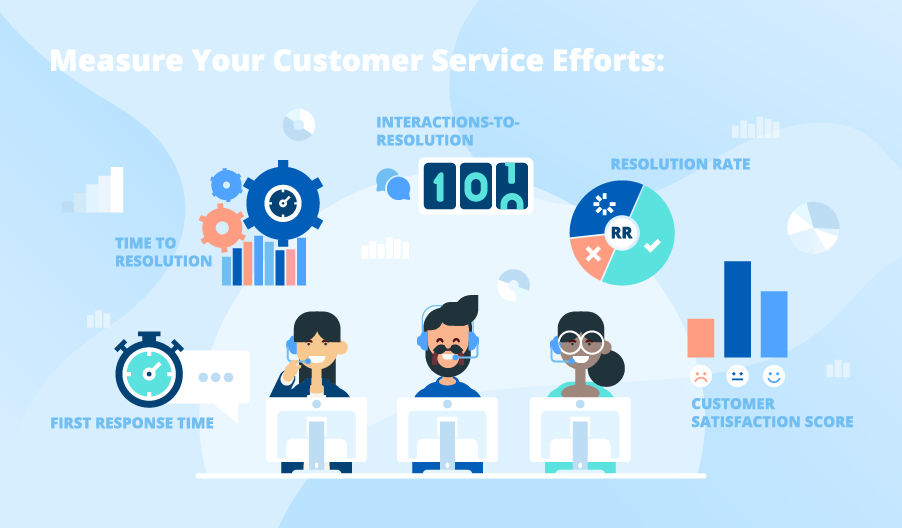5 Noteworthy Customer Service Metrics and Ways to Improve Them
Editor’s note: In the article, Anastasia dwells on the essential metrics helping to measure your customer service efforts and make the right conclusions from the figures at your disposal. In case you need more sustainable support for your customer service processes, feel free to check ScienceSoft’s outsourced help desk offer.
According to the recent stats, 49% of US consumers switched companies last year due to poor customer service. That’s why providing customer service, which is up to your clients’ expectations and quality standards, is critical for your bottom line and overall business success. To make sure your customer service is your competitive advantage rather than a weak spot, I suggest monitoring the main customer service metrics and using them for further improvements in service quality and agents’ performance. Below, I provide the selected customer service metrics worth monitoring and some experience-based takeaways for improving the performance of your support teams.

First response time (FRT)
First response time denotes how long it takes a support agent to provide an initial response to a customer’s request. Making clients wait too long may result in growing frustration, submitting multiple tickets on the same issue, and bad word-of-mouth. By contrast, if your customer service agents reply to clients as quickly as possible, it potentially leads to repeat purchases and overall revenue increase. Thus, it’s useful to know customer expectations on the acceptable first response time and bind your agents to stick to these benchmarks:
- For email – 60 minutes.
- For phone – 3 minutes.
- For live chat – 45 seconds.
- For social media – 60 minutes.
To help your customer service agents abide by these timeframes, you can set up automated replies telling your clients you’ve received their inquiry, started working on it, and will reach out to them soon. It buys your agents additional time to investigate the customer’s issue and come up with an informed and helpful answer.
Average time to resolution
The metric helps track how long customers wait for service agents to resolve their issues. It serves as an objective estimate of your agents’ productivity, since the shorter the time to handle a ticket, the more effective your team.
To spur your agents’ productivity and help them work through cases faster, you can detect the most common customer issues and set up processes and canned responses for agents to use. Additionally, you may create a number of guides on your company blog or knowledge base, describing how to solve a typical problem. Your agents could provide links to them instead of giving detailed explanations over and over again.
Interactions-to-resolution
This customer service metric reveals how many interactions with a customer your agent needs to resolve their issue. You should define the appropriate number of interactions yourself, depending on your product/service complexity and customer service workflow. Still, if the number of interactions is growing, you may assume your agents aren’t helpful enough, or the customer isn’t redirected to the right agent.
To reduce the number of interactions per ticket, you may organize training on your product/service for your staff, which allows them to be more helpful and solve customers’ issues faster.
Resolution rate (RR)
The overall resolution rate tells you what percentage of customer issues from the total number of tickets they submitted gets resolved. An increasing resolution rate is a clear indicator of your support team’s efficiency, which can be achieved with ongoing employee training and benefits for top-performers. However, to prevent your agents marking unresolved issues as “resolved” just to achieve their productivity goals, you need to have a strong process audit and QA mechanisms in place. They guarantee that issues do get resolved, and your resolution rate metric indicates the true productivity of your support team.
Customer satisfaction score (CSAT)
Customer satisfaction score is another commonly used metric, which reflects how content your clients are with your service. Although this metric can be quite subjective, it’s still worth tracking to get an idea of what customers think about the support you provide. CSAT is measured with user feedback surveys, which customers fill out after an issue resolution or a contact with a service agent. The survey contains the question asking how satisfied your clients are with the product/service they received with replies on the scale from 1 to 5. 1 stands for “Very unsatisfied”, and 5 for “Very satisfied”.
To improve your CSAT, you should pay more attention to the agents’ performance, work on the speed of their initial response, the efficiency of solutions they provide and courtesy they treat a customer with.
Your next step to enhanced customer service
Quality customer support can give your business a big advantage over rival companies. Measuring your customer service efficiency is an important step to take for providing great customer experience, along with embracing multiple communication channels, gathering customer feedback after every interaction and training your support staff. If you need more detailed guidance on how to rate customer service and improve it, feel free to contact our team.

